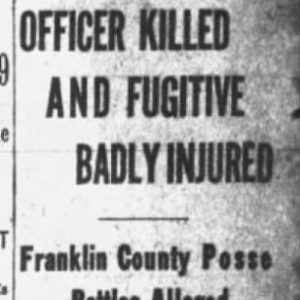calsfoundation@cals.org
Logan County Draft War
aka: Franklin County Draft War
The Logan County Draft War was an episode of armed draft resistance in Arkansas during World War I. Following on the heels of the more infamous Cleburne County Draft War, the Logan County incident—which actually took place predominately in Franklin County, and later in the wooded area near Mount Magazine—followed the familiar pattern of previous draft skirmishes in which a local posse encountered suspected draft evaders, resulting in a shootout, a death, and then a wider manhunt.
On August 5, 1918, authorities from Ozark (Franklin County) assembled a posse of seven men led by a Constable Horton to investigate the farmhouse of J. H. Benson near Cecil (Franklin County). It is unclear from the sources whether this posse was formed to apprehend local draft evaders or investigate the theft of chickens—or, likely, a combination of the two. When approaching the Benson farmhouse, the men were suddenly fired upon from the surrounding thicket. In the ensuing gunfight, posse member Jim Wood was killed, while one of the resisters was injured and another captured; these were later identified as brothers Oscar and Mike Scott, respectively. It happened that the name J. H. Benson was the alias of Jim Scott, another of the five Scott brothers, transplants from Oklahoma and career criminals who had been using the farmhouse to store stolen goods. The remaining gang members escaped capture; these included Jim and Homer Scott (some sources indicate their father, J. D. Scott, was also present) as well as one Harry Huffman, whose relationship with the Scott family is unknown.
It is ambiguous whether the Scott brothers were actually organized draft resisters in either Arkansas or Oklahoma, or if they were simply suspected of it in conjunction with their robust criminal histories. The alarmist nature of the sources, which initially reported stores of ammunition and dynamite at the “Benson” farmhouse, seems to indicate that the fear of widespread draft resistance on the heels of the Polk County and Cleburne County incidents somewhat eclipsed the facts. Given that the Scott brothers were from Oklahoma, officials also feared a link between the current draft resistance in Arkansas and the Green Corn Rebellion of August 2–3, 1917, during which a handful of tenant sharecroppers, many of whom were of African American and Native American descent, rose up in protest against the national draft. The rebellion occurred in Pontotoc County, Oklahoma, but was hastily stifled by authorities, resulting in three deaths and hundreds of arrests. Records do not indicate whether the Logan County Draft War had any formal connection to the events in Oklahoma, but there are fairly crucial distinctions: the Green Corn Rebellion was perpetrated by well-organized sharecroppers with loose ties to the Industrial Workers of the World (IWW) and the Working Class Union (WCU), whereas the Logan County resisters, much like their counterparts throughout Arkansas, were disorganized, isolated, and fiercely self-reliant, without any notable ties to a political organization.
A larger manhunt for the escaped resisters resulted in the apprehension of Homer Scott near Ozark on August 9, 1918. Captain D. W. Rosser of the Hartman Home Guards reportedly captured Harry Huffman after pursuit through the craggy Bear Hollow region of Logan County shortly thereafter. It is unclear whether Jim Scott was ever apprehended. On September 21, 1918, Harry Huffman and Oscar Scott were convicted of the first-degree murder of Jim Wood and sentenced to life imprisonment. Mike Scott and a fifth brother, Ed Scott, who does not appear to be involved in the shootout, were both indicted for robberies committed in Van Buren (Crawford County). Homer Scott was charged only with draft evasion, and he was imprisoned in Sallisaw, Oklahoma.
The Logan County Draft War does not appear to have been a “draft war” as such (nor did it take place predominantly in Logan County—this distinction appears to be given by later writers due to the manhunt through Bear Hollow), but instead it was a violent encounter by authorities with a family gang of criminals, for whom draft evasion was simply one of many crimes and not an organizing principle. There was no affiliation by the Scott family to any larger movement; rather, the fear created by other violent shootouts throughout Arkansas that year had the larger public and authorities on edge.
For additional information:
“Officer Killed and Fugitive Badly Injured.” Arkansas Gazette, August 8, 1918, p. 1.
“Ozark Murderers Not Draft Resisters.” Arkansas Democrat, August 8, 1918, p. 1
Sealander, Judith. “Draft Resistance in Arkansas to World War I.” Ozark Historical Review 2 (1973): 1–12.
“Draft Resisters Sentenced to Life.” Arkansas Gazette, September 22, 1918. p. 20.
Phillip Stephens
Fayetteville, Arkansas
 Early Twentieth Century, 1901 through 1940
Early Twentieth Century, 1901 through 1940 Logan County Draft War Article
Logan County Draft War Article 




Comments
No comments on this entry yet.